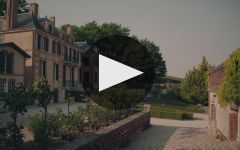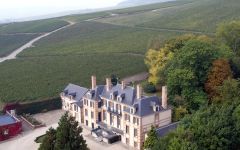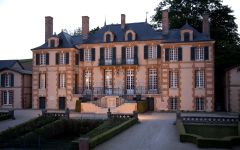Taittinger Comtes de Champagne Rose 2004
-
Robert
Parker -
Wine
Spectator -
Wine &
Spirits


Product Details
Your Rating
Somm Note
Winemaker Notes
Comtes de Champagne Rosé is elaborated and brought to maturity in the l3th century chalk cellars once belonging to the Abbey of St. Nicaise, where each step of the méthode champenoise is performed traditionally. Following harvest, the grapes are pressed immediately in press houses located among the vineyards, yielding a first pressing, referred to as the "cuvée," which is followed by two more pressings, referred to as the first and second "tailles." The greater part of the juice, and that of the finest quality, is extracted in the "cuvée;" neither of the "tailles" are used in Comtes de Champagne Rosé.
In all, no more than 100 litres (approximately 26 gallons) of juice per 160 kilograms (approximately 350 pounds) of fruit may be extracted from the combined three pressings. The juice is transported to the vinification facility, and a cool fermentation of the must takes place under temperature controlled conditions, after which the wine rests until the end of the winter. Blending for color occurs after the primary fermentation, and thereafter the final cuvée undergoes the secondary fermentation in the bottle at 45 to 50 F in Taittinger's cool cellars, during which the wine acquires complexity and the fine, pinpoint bubbles characteristic of its sparkle. Prior to dégorgement, Comtes de Champagne Rosé is aged five to seven years to fully capture the elegant complexity and full body of the Pinot Noir grape.
This sublime rosé Champagne, produced from Pinot Noir (70%) and Chardonnay grapes in years exceptional enough to declare a vintage, is appropriately presented in an antique-style bottle of XVIIIth century design. Typical of the Taittinger style, Comtes Champagne Rosé is a wine of exquisite refinement; its brilliant salmon pink color is punctuated by fine, lasting pinpoint bubbles. The sweet, red berry fragrance of the variety is offset by very subtle notes of earth and minerals. Clean, vibrant red fruit flavors are confirmed on the generous palate, balanced by a crisp, refined acidity which carries into an elegant, complex finish of considerable persistence.
Professional Ratings
-
Robert Parker's Wine Advocate
Taittinger's 2004 Brut Comtes de Champagne Rosé is showing brilliantly, bursting from the glass with an expressive bouquet that mingles aromas of rhubarb compote, red plums and spices with notions of dried white flowers, pastry cream and toasted brioche. On the palate, it's medium to full-bodied, broad and vinous, with impressive depth and chalky structure, succulent acids and a long, precise finish. While the 2004 Comtes Rosé is drinking beautifully today, it is evolving comparatively slowly by the standards of this classically balanced but somewhat rapidly evolving vintage, and it should offer immense pleasure for the better part of two decades.
-
Wine Spectator
Displays impressive finesse, centered around the finely detailed texture and well-knit acidity, all of which finds lovely integration with the subtle flavors of spiced plum, white raspberry and biscuit, complemented by a hint of hazelnut. Smoky finish. Drink now through 2024.
-
Wine & Spirits
A sophisticated rose tightly built on wild raspberry scents and orange citrus flavors, this balances richness and refinement, leaving the mouth feeling clean. Lithe limestone acidity lends it shape and contour. For the cellar.
Other Vintages
2009-
James
Suckling -
Robert
Parker -
Wine
Spectator
-
Robert
Parker -
Connoisseurs'
Guide -
Wine
Spectator -
Wine &
Spirits
-
Wine
Enthusiast -
Robert
Parker








Champagne Taittinger was established in 1931 by Pierre Taittinger on the foundations of Forest-Forneaux, itself established in 1734 and the third-oldest wine producing house of Champagne. Taittinger is today proprietor of approximately 600 acres of vines among which are included parcels in the one hundred - percent rated villages of Cramant and Avize in the Cote des Blancs; and Bouzy, Mailly, Ambonnay and Verzenay in the Montagne de Reims. The Taittinger Estate is one of the three most extensive in the Champagne district, and the firm's major holdings in Chardonnay vineyards are the physical expression of the Taittinger philosophy and style.

What are the different types of sparkling rosé wine?
Rosé sparkling wines like Champagne, Prosecco, Cava, and others make a fun and festive alternative to regular bubbles—but don’t snub these as not as important as their clear counterparts. Rosé Champagnes (i.e., those coming from the Champagne region of France) are made in the same basic way as regular Champagne, from the same grapes and the same region. Most other regions where sparkling wine is produced, and where red grape varieties also grow, also make a rosé version.
How is sparkling rosé wine made?
There are two main methods to make rosé sparkling wine. Typically, either white wine is blended with red wine to make a rosé base wine, or only red grapes are used but spend a short period of time on their skins (maceration) to make rosé colored juice before pressing and fermentation. In either case the base wine goes through a second fermentation (the one that makes the bubbles) through any of the various sparkling wine making methods.
What gives rosé Champagne and sparkling wine their color and bubbles?
The bubbles in sparkling wine are formed when the base wine undergoes a secondary fermentation, which traps carbon dioxide inside the bottle or fermentation vessel. During this stage, the yeast cells can absorb some of the wine’s color but for the most part, the pink hue remains.
How do you serve rosé sparkling wine?
Treat rosé sparkling wine as you would treat any Champagne, Prosecco, Cava, and other sparkling wine of comparable quality. For storing in any long-term sense, these should be kept at cellar temperature, about 55F. For serving, cool to about 40F to 50F. As for drinking, the best glasses have a stem and a flute or tulip shape to allow the bead (bubbles) and beautiful rosé hue to show.
How long do rosé Champagne and sparkling wine last?
Most rosé versions of Prosecco, Champagne, Cava or others around the “$20 and under” price point are intended for early consumption. Those made using the traditional method with extended cellar time before release (e.g., Champagne or Crémant) can typically improve with age. If you are unsure, definitely consult a wine professional for guidance.

Associated with luxury, celebration, and romance, the region, Champagne, is home to the world’s most prized sparkling wine. In order to bear the label, ‘Champagne’, a sparkling wine must originate from this northeastern region of France—called Champagne—and adhere to strict quality standards. Made up of the three towns Reims, Épernay, and Aÿ, it was here that the traditional method of sparkling wine production was both invented and perfected, birthing a winemaking technique as well as a flavor profile that is now emulated worldwide.
Well-drained, limestone and chalky soil defines much of the region, which lend a mineral component to its wines. Champagne’s cold, continental climate promotes ample acidity in its grapes but weather differences from year to year can create significant variation between vintages. While vintage Champagnes are produced in exceptional years, non-vintage cuvées are produced annually from a blend of several years in order to produce Champagnes that maintain a consistent house style.
With nearly negligible exceptions, . These can be blended together or bottled as individual varietal Champagnes, depending on the final style of wine desired. Chardonnay, the only white variety, contributes freshness, elegance, lively acidity and notes of citrus, orchard fruit and white flowers. Pinot Noir and its relative Pinot Meunier, provide the backbone to many blends, adding structure, body and supple red fruit flavors. Wines with a large proportion of Pinot Meunier will be ready to drink earlier, while Pinot Noir contributes to longevity. Whether it is white or rosé, most Champagne is made from a blend of red and white grapes—and uniquely, rosé is often produce by blending together red and white wine. A Champagne made exclusively from Chardonnay will be labeled as ‘blanc de blancs,’ while ones comprised of only red grapes are called ‘blanc de noirs.’
